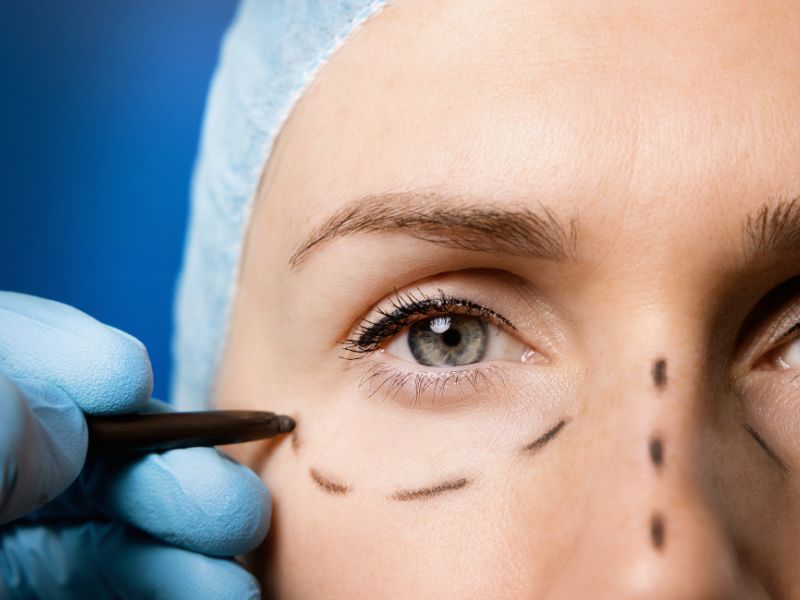Anti-aging
Lift sagging skin for a more youthful face
facial incision lift
Incisional facelift (face lift)

An incisional face lift (facelift) is a surgical procedure to improve sagging and deep wrinkles on the face due to aging and to restore a youthful appearance. Incisions are made mainly around the ears and temples to not only lift sagging skin, but also the fascial layer called “SMAS (superficial fascia)” under the skin. By approaching this deep tissue, it is possible to improve not only the surface of the skin, but also the underlying cause of sagging.
This procedure is particularly suitable for improving sagging skin over a wide area such as the cheeks, face line, and neck, and is recommended for those who have had insufficient results from non-ablative procedures such as hyaluronic acid injections and laser treatments. The effects after the procedure vary from person to person, but generally last for 5 to 10 years.
At our clinic, we provide careful counseling and treatment that is tailored to the concerns and wishes of each patient. If you are considering an incision lift, please feel free to consult with us. Our experienced doctors will strive to improve your concerns with a safe and secure procedure.
Incisional facelift is recommended for
- Those concerned about sagging neck and wrinkles
- Those who want to improve sagging face lines and double chins
- Those who have noticeable lines and marionette lines that make them look older
- Those who are concerned about sagging and deep wrinkles across the face due to aging
- Those who have had insufficient results with non-ablative lifting
- Those who want long-term lifting results
- Those who want to regain an overall youthful appearance

Features of our incisional facelift

Custom-made Treatment Plans
Each patient’s facial structure, degree of sagging, and desired image of the finished product are different. At our clinic, we listen carefully to our patients’ wishes through a thorough consultation to develop an optimal treatment plan.
For example, we offer customized treatments for patients with mild sagging, such as a small face lift, and for those who desire extensive improvement, a treatment that covers the entire face and neck area. This individualized approach allows us to provide results that are highly satisfactory to our patients.
Devices to minimize pain and burden
Since our facelift procedure involves incisions, we take every precaution to minimize pain so that our patients do not feel discomfort during and after the surgery. During surgery, we use general or local anesthesia to ensure that patients can undergo the procedure in a relaxed state.
For postoperative pain, we utilize painkillers and icing to help ensure a comfortable recovery period. We also provide specific advice on postoperative care to minimize postoperative swelling and inflammation.
Consideration for a discreet scar finish
In our incisional facelift, we design the incision sites to be located in areas where scars are less noticeable, such as around the ears and at the hairline. Furthermore, sutures are carefully and meticulously sutured to achieve a natural-looking result with virtually no visible postoperative scarring.
We also provide a full range of postoperative care products and follow-up services to help make the scars heal more beautifully and less noticeable over time. This attention to detail has earned us high praise from our patients.
Advantages of an incisional facelift

Long-lasting results
The lifting effects of an incisional facelift are generally maintained over a long period of time, typically five to ten years. While non-incisional lifts (such as thread lifts and laser treatments) require maintenance every few years, an incisional facelift does not require such frequent revision procedures. Therefore, it is very efficient in terms of total cost and effort. In addition, since the aging process is relatively natural over time, there is no unnaturalness when the effect disappears.
A wide range of sagging can be improved.
The incisional facelift can improve sagging in a wide range of areas at once, not only in the entire face but also in the neck area. For example, it is effective for sagging lines, sagging around the mouth and jawline, as well as sagging and wrinkles in the neck. Age-related sagging varies greatly from person to person and may be concentrated in certain areas or spread over the entire face. The incisional facelift is flexible enough to accommodate these complex situations and can be tailored to each individual’s symptoms.
Positive Mental Benefits
The benefits of an incisional facelift do not stop at improving appearance. The improvement of sagging and wrinkled facial features will make you feel more positive every time you look in the mirror, increasing your sense of self-esteem. In addition, regaining a youthful impression can have a positive impact on your relationships at work and in your personal life. Many patients feel less anxious and stressed about the changes in their appearance that accompany aging, and are more proactive in pursuing new goals.
The risks of incisional facelift

Postoperative Swelling, Internal Bleeding, and Hematoma
Facial swelling and internal bleeding may occur after surgery. These are natural reactions to surgery and usually improve within 1-2 weeks. In addition, blood may pool under the incisions and form a swollen and painful hematoma, but the risk can be minimized with intraoperative and postoperative care. We recommend postoperative cooling, use of face bandages, and a restful lifestyle to help patients recover comfortably.
Risk of Infection
With incisional surgery, there is a risk of infection of the wound. If infection does occur, symptoms such as swelling, pain, and delayed wound healing may occur. Thorough postoperative wound care can greatly reduce the risk of infection. We provide detailed instructions on postoperative care and prescribe antibiotics as needed.
Paralysis and Sensory Abnormalities
The facial nerve is temporarily affected during surgery, which may result in difficulty moving parts of the face after surgery or dull sensation or numbness around the incision site. These symptoms often resolve spontaneously within a few weeks to a few months. At our clinic, the procedure is performed by skilled physicians and great care is taken to minimize the impact on the nerves. We also provide thorough post-operative follow-up and perform rehabilitation and additional procedures as needed.
Flow of our incisional facelift
STEP1Counseling and Examination
We will conduct a counseling session and listen carefully to the patient’s wishes and concerns. We will discuss the specific areas of sagging and wrinkles and the areas to be improved, and examine the overall condition of the face. We will also honestly tell you whether a facelift is suitable for you, the areas that can benefit from it, and the limitations of the procedure. We will also carefully explain the details of the surgery, downtime, postoperative course, precautions, and risks, so please do not hesitate to consult us if you have any questions or concerns.

STEP2Drawing up a surgical plan
Based on what we have heard during the counseling, we will create a surgical plan that is best suited for each patient. We will consider the balance of the entire face and plan in detail which part of the face will be lifted and how much, the position of the incision, and the image of the finished product.
STEP3Preparation before surgery
On the day of surgery, we will check your general health to ensure that you are in perfect condition for the procedure. We then reconfirm the design of the surgical site and share again with the patient the final result.
STEP4Anesthesia
When performing the surgery, general or local anesthesia is administered to ensure that the patient feels no pain. The type of anesthesia will be determined based on the extent of the surgery and the patient’s physical condition. During the anesthesia, we make sure that the patient is in a relaxed state so that he/she can go through the surgery with peace of mind.
STEP5Conducting the surgery
After confirming that the anesthesia is definitely working, the surgery will begin. Sutures are done with care to minimize the appearance of scars, so that beautiful lines are maintained after surgery. The surgery usually takes about 3 to 5 hours, but it varies depending on the extent and details of the surgery.
STEP6Postoperative Care and Follow-up
After the surgery, you will be asked to wear a face bandage to minimize swelling and internal bleeding. This bandage not only reshapes the face, but also helps to reduce swelling. Periodic postoperative checkups will be performed to monitor recovery, such as the next day and one week after the surgery. We will check the progress of the wound, swelling, and internal bleeding, and provide treatment as needed. We will also provide detailed information on what to expect when returning to daily life, and support patients so that they can spend the recovery period with peace of mind.



